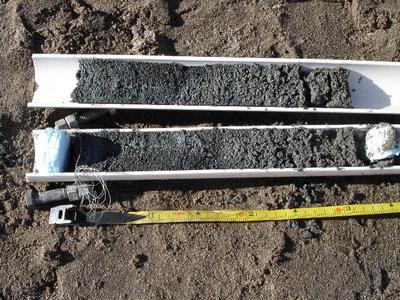
|
|
30 January, 2003
Frozen To The Core
An ASTAR helicopter flew in at 9:30 today as Tom, Brenda, and Sarah set off for Simmons Valley to look for carbonates as part of Sarah's project. They flew out in the morning and returned around 3:15 pm.
The rest of the team set off onto Lake Joyce to try to obtain a lake bottom sediment core. First Jake, Aaron, and I worked to finish boring a hole that had been started yesterday. The weather made working the equipment very difficult. Every time we would bring up the auger barrel, it was frozen to the extension poles. We tried breathing on the lever and picking away at the ice with a screw driver, but finally had to resort to our thermos of hot water to melt the ice. Once the auger barrel is separated from the extension poles, you normally just tip it and the ice cores fall out. Not so today! The ice was frozen in the barrel. So we had to use extension poles to try to bang the ice out of the barrel. Clearing a barrel normally takes one minute or less when our team is working well and the cores are cooperating. Today, it took ten minutes or more some times to clear each barrel and get it back into the hole to start cutting again. My gloves always get soaking wet when we auger and today was no exception; however, it was so cold that when they got wet, within minutes the tips were all solid ice. The front of my jacket that became wet with water, as we pulled up extensions, hardened along my zipper-flap, pockets, and sleeves. Thankfully, the jackets have flaps protecting the zipper itself or the teeth would have frozen shut as well.
We finally managed to break through the five and a half meters of ice after two hours. Although we were quite cold, we decided not to head in, but rather stay out and try to obtain a core. The decision was a good one. Within two hours, we had what we felt was a good core, considering how difficult it is to core in this lake. We had removed about thirty centimeters of silt and fine sediment. We prepared the sample, took photos, and then headed in for a late lunch.
Following lunch, we headed out again. We had hammered about one meter into the sediment the first time and we wanted to go deeper. We hammered for about twenty minutes and went down into the sediment about one and a half meters. Pulling the core barrel up was very difficult as slush above the barrel started to freeze creating a suction-like effect in the hole. The tension on the cable was at its maximum and we began to get concerned about the danger of it snapping, as well as the potential for losing our equipment. We took our time pulling it up, perhaps forty-five minutes, stopping to take turns pulling up on the hammer, thus relieving the cable tension. Once the barrel came up, we were all quite pleased to find it was very heavy and full of sediment. Problem was, it was frozen in the barrel. Using the com-along (hand winch), our usual procedure for pushing core samples out of the barrel, we found we were having no success. In fact, we actually began to bend the pole we use to push the sediment out. We had to take the barrel back to camp and let it sit in the cook tent for about an hour, hoping the warmth generated by the cook stove would help thaw the core. In the end, it took Aaron, Brenda, Jake, Tom, and Sean another forty-five minutes to remove the sediment from the barrel. This task normally would take ten minutes, but today it took over three hours total to successfully remove the sediment core. Fortunately, we were pleased to have obtained what we believe to be the deepest sediment core ever obtained from Lake Joyce.

Helo arrives to pick up Sarah, Brenda, and Tom.

Sediment core obtained from Lake Joyce.

I took off my gloves for a few minutes and they froze into this glove sculpture.
Contact the TEA in the field at
.
If you cannot connect through your browser, copy the
TEA's e-mail address in the "To:" line of
your favorite e-mail package.
|
